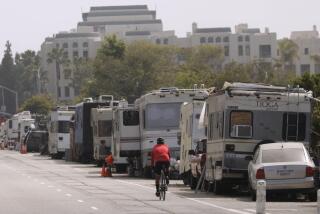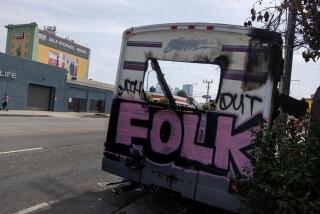Antiques or Just Old? : Law to Aid Car Collectors, Curb Junk Is Sought
- Share via
When is a yard full of old Fords an antique car collection and when is it a junkyard?
The Los Angeles City Council has asked the city attorney’s office to answer that question and come up with an ordinance to impose regulations on car collectors--and give neighbors protection from the junk collectors with unsightly yards.
The problem has been that, under existing city law, a backyard full of vintage Rolls-Royces or Model T Fords could be classified no differently from one filled with autos on blocks. If they are partly dismantled and stored outdoors, the cars are junk in the eyes of the law.
Last week, the council asked that an ordinance be prepared that would remove the authentic collections from the junkyard classification, defined by city code as lots used for storage of cars that are impounded, abandoned, partly dismantled, obsolete, inoperable or wrecked. The ordinance also would permit the outdoor storage of collections, something that is now a violation of residential zoning codes.
sh Past Citations
Collectors of historic cars have been cited in the past for open storage of the vehicles in residential areas, said Bob Steinbach, chief inspector for the conservation bureau of the city Department of Building and Safety. They can be fined up to $1,000 and the cars can be ordered removed, he said.
An ordinance to define and regulate collectors was first requested in 1984 by Councilman Howard Finn, who said his office had received complaints from residents of his northeast San Fernando Valley district that some residential properties were being turned into junkyards. Some of the junk collectors allegedly were trying to avoid city sanctions by insisting that they were collecting old vehicles that have special standing under state law.
“There are a lot of serious collectors who have historic automobiles and there are others who just pick up old cars,” Finn said. He said the ordinance is needed to differentiate the two.
The 1984 proposal never became law, however, after its restrictions and $340 fee on antique car collectors proved controversial. The ordinance now being worked up will include only a small fee to cover paper work, said Susan D. Pfann, deputy city attorney.
Finn said the ordinance will guarantee that hobbyists are not treated like junk dealers but that it will not protect people who restore old vehicles for sale or store the vehicles for any commercial use in residential areas.
“It’s the greatest thing in the world,” Granada Hills car collector Ed Cholakian said of the council’s action. “We need places to keep these cars. Before, if you had an old car, the city didn’t care if it was 40 or 50 years old, it was junk.”
70 Cadillacs
Cholakian has 70 restored Cadillacs on two acres in Sylmar. The autos are surrounded by a fence with a private access road leading to them.
The job of defining antique car collections has been assigned to Pfann, who predicted that the task will not be easy.
The ordinance will combine features of state laws and vehicle codes with regard to special-interest vehicles, historic vehicles and “parts cars”--those used to supply others--for the final definition, she said.
Under state law, for instance, a special-interest vehicle is one unaltered from the manufacturer’s specifications that is significant because it is out of production or is a model of which fewer than 2,000 were sold in California. Under state law, there is no limit on the number of such cars that can be stored on a lot as long as they do not constitute a health hazard and are screened from public view.
The state also gives some protection to vehicles “at least 25 years old and of historic value,” although they must be stored in compliance with local zoning.
Under the Los Angeles ordinance, the collections, along with plans for maintenance, will have to be approved by a zoning administrator, Pfann said.
On lots in single-family residential areas, antique car collections could cover up to 50% of the first 10,000 square feet, she said. Of the area more than 10,000 square feet, 20% could be used to store cars.
Finn said the ordinance would not allow storage of cars within five feet of a building, or in front or side yards. The cars also would have to be screened from view by fences or shrubs and not present a health hazard.
sh Fewer Limits
This latest proposal would impose fewer requirements on collectors, however, than the 1984 ordinance, which was rejected by the Los Angeles city Planning Commission. That one limited the number of cars allowed on each lot to one per 250 square feet of backyard.
“Car collectors are getting a bad rap for backyard mechanics who use their yards as a grease rack,” said Jennie Klein, a Shadow Hills resident who collects historic cars such as Packards.
“A 1930 Packard should not be called junk like a car that is up on blocks in somebody’s yard. Car collectors do not have a dirty operation. We are talking about valuable cars here.”
More to Read
Sign up for Essential California
The most important California stories and recommendations in your inbox every morning.
You may occasionally receive promotional content from the Los Angeles Times.


![Los Angeles, CA - May 19: Carlos Vargas, left, and Paulina Rubio, members of the harm reduction team from Homeless Outreach Program Integrated Care Systems [HOPICS], a leading homeless services and housing agency, look for drug addicts to help and pass out supplies at a homeless RV encampment along 77th St. in South Los Angeles Friday, May 19, 2023. The team hands out syringes, fentanyl test strips, overdose reversal nose spray and medication to prevent overdoses, infection and disease transmission, including the HIV virus. Fenanyl is particularly insidious because it can be found in all other drugs, especially meth and heroin. The handouts are also meant to reduce infection through broken pipes, which can cut users mouths and open them to infection. . (Allen J. Schaben / Los Angeles Times)](https://ca-times.brightspotcdn.com/dims4/default/530e2db/2147483647/strip/true/crop/3900x2608+0+34/resize/320x214!/quality/75/?url=https%3A%2F%2Fcalifornia-times-brightspot.s3.amazonaws.com%2Fe9%2F77%2F4b8bd35d4881a3edec6b945b143b%2F1298639-me-soaring-fentanyl-deaths-24-1-ajs.jpg)







